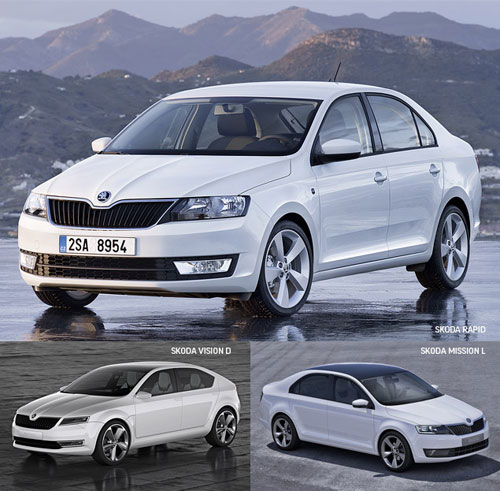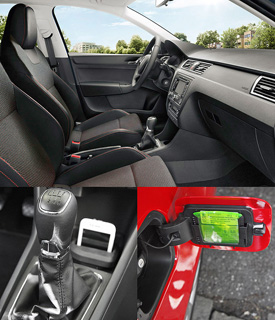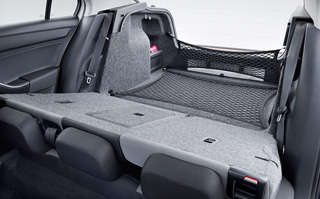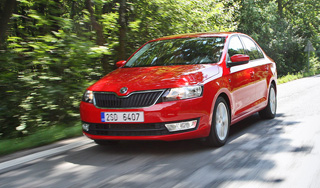Skoda Rapid test drive since 2011 sedan
Battle for the people
Test drive of the budget liftback Skoda Rapid.Skoda successful sales cause Volkswagen headquarters in Wolfsburg not only respect, but also envy. Skoda details use the same, and cars are cheaper, but no worse than Volkswagen. The new Rapid is built on the same platform as the VW Polo sedan, but it looks fresh and more interesting. What is the secret to the success of the Czech folk car?
Actually, the Czechs already had Rapid. The first in 1935, and the second in 1984, when the sports version of the terrible Skoda 130 sedan was released under this name. After almost 30 years, in 2011, Skoda showed two futuristic Vision D concepts and a more mundane Missionl. The first set a new vector for the development of the design of Czech cars for the coming years, and the second showed how the first model of the new era will look like. Moreover, the flagship Superb was chosen as a manifesto, but by the new Rapid budget model, the quintessence of the ideology of the Czech brand.

The fact that Skoda cars will change is spoke a year ago by the chief designer of the brand Joseph Kaban. Now in private conversations, the Skoda leadership says that the starting point for changing the style was not quite successful compactwane Roomster. An unusual heel, which, as planned, was supposed to be like the cabin of the aircraft, because of too complicated appearance, not everyone liked it.
New skods will become easier: clean lines, clean shapes. But most importantly, now all Czech cars will be made in a single style in the one that last year's concepts and their first serial follower, the budget Liftback Skoda Rapid.

Does the car look rustic? May be. Rather, the new Skoda will look dynamic, as if they were engaged in a fitness club. But there is no trace of the Superb.
Compared to Missionl from Rapid, unusual door handles, and expensive headlights, and dazzling white leather interior, and inserts made of rock crystal, which struck the concepts, were forgotten. Well, at least from the logo through the entire hood, those two dynamic lines are still stretched, which made the Skoda of the last generations so noticeable. The logo itself is now single -color, chrome, without a single green spot. Exactly the same as at Citigo. Huge foglights were placed under the headlights, and the hood and the radiator grille are now separate details, and not as massive as before.

The fact that Rapid is actually a liftback can only be guessed by the janitor on the back glass.
As before, the new Skoda car is built on verified Volkswagen components. Doors' handles remember several generations of concern's cars at once. The buttons in the cabin, radio, climate control unit also did not develop specially on them, only the school logos were put. Yes, and the basis of the car is the base architecture of the PQ25 platform, Rapid divides the VW Polo, Seat Ibiza and Audi A1, although it looks most in design to the Russian VW Polo sedan. It would seem that Rapid should look eclectic as a kind of automobile Frankenstein, but the talent of Skoda engineers and designers is just that they were able to smooth out all these roughnesses.
However, a smooth car seems only externally. To the touch, the new Rapid immediately gives itself out. The salon materials are very cheap. You touch the front panel and feel that it is very stiff, from rough, slippery plastic. In the doorway, instead of the usual fabric inserts, black or beige plastic, and even the steering wheel is covered with rough skin. And this is in the maximum configuration. In the opinion, it seems, nothing, but in tactile sensations, poor.

No excesses are the unspoken message of Rapid.
However, Skoda would not be a skoda if she had not invented something like that even in the budget class itself. So in Rapid, compared with the Polo sedan, 19 useful innovations were introduced. For example, a full -time scraper from snow is hidden in a gas tank hatch. A convenient pocket for trifles is sewn in the sidewall of the driver's seat, and instead of a removable ashtray, a narrow stand for a smartphone. All these things in mass production are cheap, but they are truly priceless because they give the owner a feeling of care: the manufacturer specially thought about him and decided his personal micro -problem.

In Europe, Rapid can be ordered with a sports interior Flush. But a smartphone stand and a glass scraper will be put in each car.
Another important detail that pleases any skoda huge trunk. The Rapid body is made in the elevator form factor. This means that the car looks like a sedan, although in fact the fifth door rises like a hatchback with a glass. 550 liters of volume are a very significant argument in the struggle for the buyer. At the presentation of Rapid from the trunk, six medium -sized suitcases and another net with football balls were taken out. Even on the floor of the trunk there was a place for a simple and practical solution. The rug was made to two -sided ones: either the pile or rubber, so that you can easily put dirty boots there after fishing.

Four grids in the trunk and a special double -sided mat on the floor all these options even for maximum configuration. Buyers of the simplest version will have to rely only on a full -sized spare wheel.


The passenger couch is also surprisingly spacious. There are plenty of legs, and above the head of the air is enough from the pillow to the ceiling as many as 972 millimeters practically Superb. Even if the driver turns out to be a two -meter basketball player, a person of medium height will calmly sit down in the back. How did such a trunk manage to save the space in the cabin? Everything is simple: the Czechs lengthened the German platform a little, adding the wheeled base of the Polo-sedan 50 millimeters. The passenger sofa was pushed back as much as possible, and at the expense of the fifth door to maintain the feeling of a huge trunk.
If the seats are folded, you get a very impressive cargo compartment with a volume of 1490 liters.

Finally, in an economy class car, you can sit humanly.

In the most affordable configuration, the sofa develops entirely, and the central armrest will not be at all.

If you fold the backs of the seats

fully

then the volume of the trunk will increase to 1430 liters.
In the most affordable configuration, the sofa develops entirely, and the central armrest will not be at all.
By corporate logic, Rapid should not go better than the VW Polo sedan. However, when you get into the car and start moving, you recall a completely different relative of the first generation Octavia. The Czechs not only lengthen the Rapid wheelbase, but also reconfigured the suspension. On the straight line and during acceleration, the weight of the machine is not felt, and in the bends and when braking the chassis it seems slightly more supple than on the polo. But most importantly, the Czechs managed to maintain intuitive understanding in management, which is inherent in all brand cars.
That's just in terms of stiffness, the suspension of Rapid is still European. Small holes swallow, but large ones often make the car startle the car with the whole body. I would like the clearance to increase by the time of the Russian assembly, and the suspension has become a little more tolerant of bumps. Unfortunately, with the Russian adaptation of the car, everything is foggy. The Czechs did not tell what suspension they would put, which engines will be offered to us, and the answer to the main question what the Russian price will be kept secret.

For some reason, the first generation of Octavia than Polo Sedan is more reminiscent of Rapid ride habits.
We went to the European version of the Rapid with a 1.2 engine with a capacity of 105 horsepower are exactly the same on Polo with a body of hatchback and even on Skoda Yeti. With it, the car accelerates dynamically thanks to the turbine and a well -fitted six -speed gearbox. Unlike Yeti with the same engine, Rapid does not stop gaining speed on the lifts, which means that with full load it will go well with dignity. Compared to a 1.6-liter engine with a capacity of 105 horsepower, which is placed in the Russian Polo Setan, this turbo engine has better traction.

In the near future, Skoda intends to increase the expansion of the markets of Europe, China and Asia. Czechs will be represented by a new car every six months, and by 2018 they intend to increase the annual sales of cars to 1.5 million pieces.
The differences between Skoda Rapid and Polo Sedan:
◉ Lenced by 50 millimeters platform
◉ Five -door liftback body instead of a sedan
◉ will be sold in Europe
◉ In the European version, Rapid will receive five engines options
It is possible that the same atmospheric engine that is equipped with the VW Polo sedan will put in the Russian Rapid. It all depends on the production line that is now mounted in Nizhny Novgorod, and on the final price of the car. Europeans will get three options for 1.2 liters from 75 to 105 horsepower and another 1.4 -liter engine with a capacity of 122 horsepower. There are only two diesel engines. Both of the same volume of 1.6 liters, but of different capacities: 90 or 105 horsepower.
A six -speed manual box is put only on a gasoline engine 1.2 105 forces. Everyone else receives mechanics with five steps, and a dry seven-speed DSG acts as an automatic transmission, which can only be ordered with a 1.4 liter with a capacity of 122 horsepower or with a 90-horsepower diesel engine.
What else did you remember? That the seats are quite enough for any driver that all governing bodies are in their usual places. The one who went to Passat, Jetta, Golf or Octavia will find any button with his eyes closed. The only minus of ergonomics from the driver’s place can only be opened with the front glass, since there are only two keys in front. Strange, because there is also a key behind. Why in a family sedan they used such a solution and how much money saved on this little things is not clear. Indeed, in the Polo sedan on the door of the driver there are all four keys.
Noise insulation in Rapid can not be called perfect. At a speed of 100 kilometers per hour of the engine, it is not heard, but it is rather a merit of a six -speed box. When accelerating and simply at high speeds, the engine sings in the whole throat. You can hear the noise of the wind from the mirrors and the rumble of tires, but in this segment such disadvantages are the norm.

Powerful fog lights help the driver not only in conditions of poor visibility. Thanks to the optional Corner function, they highlight turns and curbs depending on the rotation of the steering wheel.
Will Rapid a folk car? Without a doubt. Especially if the Czechs manage to hold the price level at least at the level of the Russian VW Polo sedan. The car looks more interesting, rides more dynamic and will be practical than most competitors. But with the date of its entry into our market, everything is vague.
So far, it is only clear that before mid -2013 living cars will not reach Russia. However, if a decision is made not to start sales, until they put production in Nizhny Novgorod, you will have to wait for the end of 2013 or even the beginning of 2014. Here problems may begin. Indeed, by this moment, the twin brother of Rapid Seat Toledo will also appear on the same conveyor. An interesting task for marketers will be: to dilute three almost identical cars Polo Sedan, Skoda Rapid and Seat Toledo into separate niches. And decide which of them should become the most popular.
Alternative
Volkswagen Polo Sedan. The only Volkswagen that corresponds to the name of the folk car. At the moment, it is available with a 1.6 engine with a capacity of 105 horsepower with a machine gun or a manual gearbox. Prices start from 411,000 rubles, but almost all interesting options will have to be paid extra.
Hyundai Solaris. Hyundai was able to offer not only a good price for its Solaris, but also to establish powerful production. The choice of two engines 1.4 and 1.6, 107 and 122 horsepower, respectively. As well as two types of bodies: hatchback and sedan. The initial price of the hatchback is 443,000 rubles.
Kia Rio. Rio is almost the same as Hyundai Solaris, it only looks better thanks to design with European roots and slightly better decoration materials. Engines and options for completion are practically identical to Solaris. Hatchback prices start at 489,000 rubles.

Eco -version for europa
Rapid Green TEC cars with gasoline and diesel engines will be equipped with special tires with reduced rolling resistance, as well as Start-Stop systems and energy recovery. At traffic lights, the engines will turn off so as not to consume fuel at all. When braking and driving with a constant speed of excess electricity, they will be stored in a standard battery. Its capacity is just enough to nourish the side network during stops at traffic lights. Unfortunately, the climate control only will not be able to feed with electricity and will periodically turn on the engine to maintain a given air temperature in the cabin. Not a hybrid, of course, but still Rapid Greet Tec consume from 5 to 8 percent less fuel than conventional Rapid.
Technical characteristics of Skoda Rapid
1.2 TSI
The type of gasoline engine with direct fuel injection and turbocharged
Working volume, cubic meter. cm 1197
Max. Power, L.S./rpm 105/5000
Max. moment, nm/rpm 175/15504100
Type of drive front -wheel drive
Mechanical transmission, five -speed
Front suspension Independent spring McPherson
Rear suspension half -dependent spring
Brakes Disc ventilated in front and drum in the back
Dimensions (DHSHHV), mm 4483x1706x1461
Wheel base, mm 2602
Equipped mass, kg 1175
Max. Speed, km/hour 195
Acceleration 0100 km/h, from 10.4
Fuel consumption (comb.), L/100 km 5.4
Fuel tank volume, l 55
The volume of the luggage compartment, l 5501490
Tire size 185/60 r15
Price, rubles n/d
Source: Motor magazine [August 2012]







